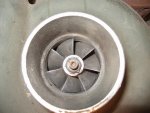Thanks Jason. ERROR was between keyboard and chair.
So 2.5"/2=1.25"x1.25"x3.14=~4.9sq inch x 15psi=73.5lbs.A lot less than the 117 I stated - but still a factor. I'll skip the stem as the valve size is a guess.
Ken,
I might have to [respectfully] disagree with fuel efficiency being #1. For engines (all things being equal) it does improve fuel efficiency by reducing pumping losses. It may allow an engine do the same work at a lower engine speed, or allow a designer use smaller(thus lighter)engine...It's a benefit but the latter two don't apply here. I'd think If someone wanted to improve fuel economy they have come up with a diff gearset for the trans or transfer case.I wish they had.
TM 9-2320-361-10 page 1-18 reads:
Fuel consumption*
-LD-465-1/1C---- 5 - 6mpg
-LDT-465-1D---- 5.15 - 6.18mpg
*based on diesel fuel and 1500rpm
I read (somewhere here) the LDT's turbo was a solution for the smoke issue. Some gov agency(EPA?) granted the manufacturer a waiver to build additional vehicles if they were cleaned up. I think that post said a subsequent production run was denied. That may have signaled the end of the M35 series (and at a time when emissions became a major concern ~ after 1970). Smoke would be my #1 "as designed".
Most turbos are used for more power. My #1 "in general". The LDS turbo seem all about power. My commercial Mack as almost undrivable when the compressor's t-bolt clamp breaks (a common problem(3x)/ might manage 30MPH w/oT). Turbos get more O2 in the chamber. Power comes if there is available fuel. More efficient?Yes. More fuel used?Yes.
The manifold may act as a aftercooler but it's efficiency would drop to 0% as the water temp reaches the charge temp. Maybe a super high boost would benefit some. Even if the manifold is colder there is not a lot of surface area inside. Efficiency would be extremely poor. I took a quick look for a sample compressor discharge temp(HP - Turbochargers). I'll give just the results -247*F (15psi/ 300cid/ 350HP/ 80*amb/ 70% comp eff).
Text states:
"If jacket water is used as the cooling media,at 180*F the temp drop will be (250-180) x .7=49*F . This results in a charge air temp of 210*F. The small decrease makes it impractical unless the compressor discharge temp is at least 300*F."
Note: this example is a water to air intercooler with 70% eff. rating, not an intake manifold housing, running 15psi boost, and only 180*F coolant.
That LDS wastegate is a big player. Wastegates allow[a different] turbo to run in the most efficient part of the compressor map. The turbo may create more boost at lower RPM and protect against excessive turbine speed and overboost . Less compromises.
JWaller,
25psi? A LDT turbo might help.
An intercooler too.
Last night I tried to think up a good location for one. Still thinking.JimK



